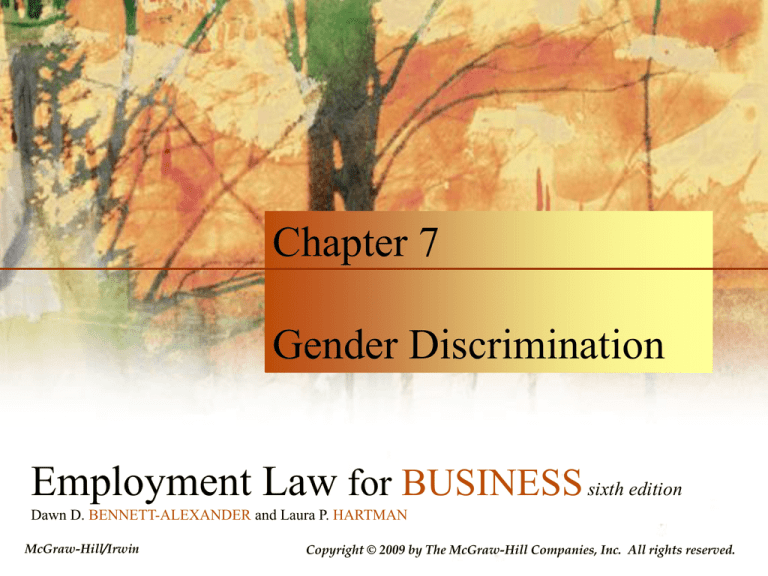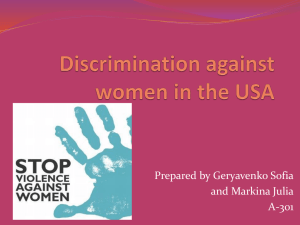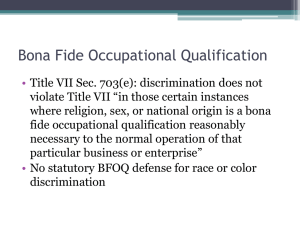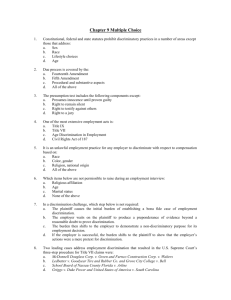
Chapter 7
Gender Discrimination
Employment Law for BUSINESS sixth edition
Dawn D. BENNETT-ALEXANDER and Laura P. HARTMAN
McGraw-Hill/Irwin
Copyright © 2009 by The McGraw-Hill Companies, Inc. All rights reserved.
Statutory Basis
It shall be an unlawful employment practice for an employer—
(1) to fail or refuse to hire or to discharge any individual, or
otherwise to discriminate against any individual with respect to his
compensation, terms, conditions, or privileges of employment,
because of such individual’s . . . Sex [gender]. . . . Title VII of the
Civil Rights Act of 1964, as amended. 42 U.S.C. 2000e-2 (a).
(1) No employer . . . shall discriminate between employees on the
basis of sex by paying wages to employees . . . at a rate less than
the rate at which he pays wages to employees of the opposite sex . .
. for equal work on jobs the performance of which requires equal
skill, effort, and responsibility, and which are performed under
similar working conditions, except where such payment is made
pursuant to (i) a seniority system; (ii) a merit system; (iii) a system
which measures earnings by quantity or quality of production; or
(iv) a differential based on any other factor other than sex. . . .
Equal Pay Act, 29 U.S.C.A. §206(d).
7–2
Statutory Basis (continued)
(k) The term “because of sex” or “on the basis of sex”
includes, but is not limited to, because of or on the basis
of pregnancy, childbirth, or related medical conditions;
and women affected by pregnancy, childbirth, or related
medical conditions shall be treated the same for all
employment-related purposes, including receipt of
benefits under fringe benefit programs, as other persons
not so affected but similar in their ability or inability to
work. . . . Pregnancy Discrimination Act, 42 U.S.C.
§2000e.
7–3
Does it Really Exist?
• Recognizing gender discrimination
• Gender discrimination covers both males
and females
– The vast majority of EEOC gender claims
are filed by women
• The Merrill Lynch message
• “Contraceptive equity”
• Hiring discrimination vs. on the job
issues
7–4
Does it Really Exist? (continued)
• Nearly half the workforce is female
– Females represent two-thirds of all poor adults
• Only 15 percent of women work in jobs typically held
by men
• Women earn about 77 percent of men’s pay
• The gender-based wage gap is present in every
profession
• Glass ceilings
• In Fortune 1000 industrial and Fortune 500 service
firms, 97 percent of top managers are white males
• Gender was not originally part of the Civil Rights Act
• By law it is the person’s ability that must be the basis
for workplace decisions
7–5
Gender Discrimination
in General
•
•
•
•
•
•
•
•
•
•
Advertising
Application questions
Interview questions
Different hours or job positions
Discipline
Training
Seniority systems
Wages and benefits
Terms or conditions of employment
Termination
7–6
Gender Myths
• Women are better suited to repetitive, fine motor
skill tasks.
• Women are too unstable to handle jobs with a great
deal of responsibility or high pressure.
• Men make better employees because they are more
aggressive.
• Men do not do well at jobs requiring nurturing
skills, such as day care, nursing, elder care, and the
like.
• When women marry they will get pregnant and
leave their jobs.
7–7
Gender Myths (continued)
• When women are criticized at work, they will
become angry or cry.
• A married woman’s income is only extra family
income.
• A woman who changes jobs is being disloyal and
unstable.
• A woman should not have a job that requires her to
have lunch or dinner meetings with men.
• Women should not have jobs that require travel or a
good deal of time away from home.
7–8
Appearance-Based Discrimination
• Attractive men and women earn more than
plain men and women
• Overweight men and women earn less than men
and women who are average or underweight
• Taller men and married men earn more than
shorter men and single men
• Plain women tend to attract the lowest quality
husbands; beautiful women do no better in
marriage than average women; looks don’t
seem to affect men’s marriage prospects.
7–9
Recognizing Gender
Discrimination
• Does the policy exclude members of a
particular gender from the workplace or
some workplace benefit?
• Do height and weight requirements
statistically exclude certain groups?
– Do these requirements directly correlate to
ability to do the job?
7 – 10
“Gender-Plus” Discrimination
• Women who:
–
–
–
–
–
Are pregnant
Are married
Are over a certain age
Have children of a certain age
Are unmarried with children
• Males are not subject to the same
limitations
7 – 11
Gender Stereotyping
• Workplace decisions based on:
– Ideas of how a particular gender should act
or dress
– What roles they should perform
• Prohibited by Title VII
• Frequently leads to actions that form the
basis of unnecessary liability for the
employer
7 – 12
Grooming Codes
• Title VII does not prohibit an employer
from using gender as a basis for
reasonable grooming codes
• Employers can use reasonable standards
of what is generally thought to be maleor female-appropriate attire in a business
setting
• Perceptions of the employee in the
workplace
• Gender-based grooming policies
7 – 13
Customer or Employee
Preferences
• Customer preference is not a legitimate
and protected reason to treat otherwisequalified employees different based on
gender
• Hooters
• U.S. citizens employed by Americanowned or controlled companies doing
business outside the United States
7 – 14
Logistical Considerations
• Breast-feeding for working mothers
• Employers may not forgo hiring those of
a certain gender because of logistical
issues unless it involves an unreasonable
financial burden
• Examples:
– Female sports reporters
– Female firefighters
– Bathroom facilities
7 – 15
McGraw-Hill/Irwin
Equal Pay and Comparable Worth
• Despite the Equal Pay Act, women earn on
average 77 cents for every dollar earned by
men.
– Women’s salaries may be equal by the year 2050
• The EPA overlaps with Title VII’s general
prohibition against discrimination in
employment on the basis of gender.
– EPA is concerned with the content of the job
• Comparable worth
• Fair Pay Act
• Paycheck Fairness Act
7 – 16
Gender as a BFOQ
• Title VII permits gender to be used as a
bona fide occupational qualification
under certain limited circumstances.
• BFOQ can be used when there is a
legitimate need for authenticity.
• BFOQ as a defense generally found
inapplicable.
7 – 17
Pregnancy Discrimination
• The Pregnancy Discrimination Act
amended Title VII’s definitions to include
discrimination on the basis of pregnancy
• 182 percent increase in the filing of
pregnancy discrimination charges over
the past 10 years
• Inability to perform vs. pregnancy
7 – 18
Fetal Protection Policies
• Limit or prohibit employees from
performing certain jobs or working in
certain areas
• Many times these policies only exclude
females
Fetal protection policies
Policies an employer institutes to protect the fetus or the
reproductive capacity of employees.
7 – 19
Summary
• Discrimination on the basis of gender is illegal.
• Gender discrimination has many manifestations.
• In determining whether employment policies are gender
biased, look at the obvious, but also look at the subtle
bias that may arise from seemingly neutral policies
adversely impacting a given gender, such as height and
weight requirements. Both types of discrimination are
illegal.
• Where employees must be treated differently, ensure
that the basis for differentiation is grounded in factors
not gender-based but, instead, address the actual
limitation of the employee or applicant’s qualifications.
7 – 20
Summary (continued)
• Dress codes are not prohibited under Title VII, but dress
code differences based on gender should be reasonable
and not based on gender stereotypes.
• Logistical concerns of bathrooms, lactation rooms, and
other such matters should be handled in a way that does
not overly burden or unnecessarily exclude either gender.
• Under the PDA, employers must treat a pregnant
employee who is able to perform the job as they treat any
other employee with a short-term disability.
• Because of health and other considerations, an employer
may use pregnancy as a BFOQ and may have policies
excluding or limiting pregnant employees if there is a
reasonable business justification for such policies.
7 – 21
Summary (concluded)
• If there are legitimate bases for treating pregnant
employees differently, an employer has
flexibility to make necessary decisions.
• Outmoded ideas regarding pregnant employees
may not be the basis of denying them equal
employment opportunities.
• Fetal protection policies may not operate to
discriminate against employees and fail to extend
to them equal employment opportunities.
7 – 22








